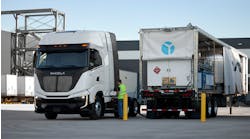Liftgates come in a variety of styles and sizes to assist with a variety of cargo-loading applications. Regardless of which type of liftgate is installed on a truck, the general functionality is the same. So is the source of most liftgate performance issues.
“We see that anywhere from 60 to 75 percent of issues on a truck are electrical, 10 to 20 percent are mechanical, with the rest being hydraulic-related,” says Kurt Walker, a product manager with Anthony Liftgates, a manufacturer of liftgates. “The same thing can be said about liftgates.”
Anton Griessner, vice president of marketing and business development for Maxon Lift Corp., tends to agree. “When looking at warranty reports, we see that 80 percent of the issues our customers deal with ties to low voltage,” Griessner says. “With anti-idling laws, drivers can’t run the tractor while unloading, so they are dependent on the auxiliary batteries mounted back at the trailer.” Maxon Lift is also a manufacturer of hydraulic liftgates for trucks.
As Griessner relates, a driver might make a stop, operate the liftgate five or six times, stow the liftgate and drive to the next stop. In many cases, that next stop might only be a mile or two away. “The auxiliary batteries get some charge, but are not fully recharged,” Griessner points out. “By the end of the day, the batteries are completely depleted.”
Low-voltage situations can end up burning out solenoid switches and harnesses, as well as cause damage and subsequent premature failure to motors. “This is where fleets can run into a lot of problems,” Griessner says.
There are certain precautionary measures fleets can take, Griessner adds. “Separators, for example, don’t allow batteries to drain as much. You can also put battery state-of-charge gauges on the liftgate controls. If the charge is too low, the driver is alerted and knows he or she has no choice but to start the tractor to get the liftgate operating. But, even with measures such as these, low-voltage situations continue to be a problem for the fleet industry.”
Terry Eyink is an engineer with Thieman Liftgates, another manufacturer of hydraulic liftgates. He says electrical connections and grounds are always critical to get signals from the 12V positive source to the switches and valves. They are also critical for current to flow properly from the battery source through the DC loads on the liftgate, to grounding points, and back to the battery’s negative post. “Breaks or weak connections anywhere in that loop will not allow current to flow properly,” Eyink points out.
So, what can a fleet do?
“A loose terminal can cause problems,” Walker says. “Corroded connections can cause problems. A wire rubbing against a sharp edge can wear through and short out, also causing problems. It’s a good practice to run through the electrical connections every three to six months. Hit them with a wrench and make sure everything is tight. Visually inspect for balls of corrosion. Make sure the grounds are good. These are all basic maintenance items that can make a big difference with the uptime of the liftgate.”
Voltage testing is another important step fleets can take. However, Eyink says technicians often make one critical mistake. “Technicians often check voltages when there is no electrical load on the system,” he explains. “Many electrical problems can only be easily located when there is an electrical load because current multipled by resistance - resistance caused by weak connections - results in voltage drops.”
According to Eyink, a technician could ask someone for assistance by hitting a switch to activate the liftgate. While safely positioned away from the path of the moving liftgate, the technician can check to see if the voltage stays up in the necessary 10.5V to 11V range, or if it drops down to around 3V or 4V. “Many solenoids and valve coils won’t even function if voltages drop below 9.5V,” Eyink adds.
Specifying a liftgate
Electrical issues are common for all types of liftgates. Fleets should keep that in mind when drivers report liftgate performance issues. There are also some key items fleets should keep in mind when specifying a liftgate in the first place.
For starters, Thieman Liftgates’ Eyink says fleets need to identify the required cargo capacity, along with the types of cargo they’ll be unloading and how they’ll go about unloading it. “A fleet may choose one style if it is unloading milk crates from the side of a refrigerated trailer but would want a completely different style of lift if unloading pallets from the back of a box truck,” Eyink explains.
Maxon’s Griessner says factors such as capacity and cargo handling are important aspects to evaluate as part of what he calls a five-step liftgate selection process.
1. Type and size of vehicle. The chassis a fleet uses, along with bed height and associated overhangs, limits which liftgates are practical. “For instance, if the bed height is really low, it is hard to use a “tuck-away” liftgate because there isn’t any room to fold it out,” Griessner explains. This liftgate style features a foldable platform that collapses and stores under the back of the trailer.
2. Type and handling of load. Is the cargo palletized? What are the dimensions and weight? What type of pallet jack will the driver be using? Is the driver loading bread carts that are high and may tip over easily, requiring a liftgate with a platform that remains perfectly level? Those are the types of questions fleets should be asking.
3. Capacity. “It sounds like an easy thing, but there is a lot to keep in mind,” Griessner says. “It’s a good idea to spec for the worst-case scenario, even if it’s a one-off load.” For instance, if the driver will ever be unloading pallets of water with a 700- or 800-lb electric pallet jack or even 200-lb manual jack, that is a lot of weight. And don’t forget about that driver, whom, Griessner says, should be estimated to weigh 250 lbs.
“Things like driver weight and pallet jack weight are often forgotten in this equation,” Griessner says. “Whatever number you arrive at, make sure you have a liftgate with that capacity. If a fleet has a liftgate without the necessary capacity, it will often run into efficiency issues because the liftgate becomes slow or can’t lift at all. There are also safety issues because an overburdened lift will break down sooner or later.”
4. Type of liftgate. Fleets should think about how often they will need to use the liftgate. “This depends very much on the specific application and how many stops a driver will make in a given day,” Griessner says.
5. Bed height. Just like with capacity, fleets should spec for the worst-case scenario, which is a fully laden truck or trailer, and whatever the minimum bed height is a driver can work with. For instance, one of Maxon’s premium Tuk-A-Way brand liftgates needs at least 46” laden bed height or it cannot be stored away.
Anthony Liftgates’ Walker says fleets should also pay attention to a dedicated ground cable. “Over the years, fleets would often charge trailer liftgates through a single power cable running back to the dedicated batteries on the trailer,” Walker says. “They would often ground back through the fifth wheel, but that can cause problems because it isn’t a good connection. The same thing can happen on a straight truck. The ground should always be as direct as possible to get the best pull of electricity.”
Eyink says the most common missteps fleets make when specifying liftgates relate to cargo weight, bed height, and if cargo door access without using the liftgate is required. Other frequent missteps tie to battery charge.
“Fleets don’t always consider drive time between stops, the number of liftgate cycles per stop, or idle time to shutoff,” Eyink says. “These things help ensure they will have enough power to run their liftgate correctly. Considering this will help to determine if optional charging kits are necessary, along with which one is right for them.”
According to Griessner, fleets need to spend time thinking about the recharging issue when specifying a liftgate. “Fleets need to understand how much is demanded of the liftgate—then they can specify it correctly,” Griessner says. “With an energy usage profile, liftgate manufacturers can recommend alternative charging solutions such as supplementary solar, or perhaps a DC/DC converter system that brings a certain amount of charge back to the batteries. This is very much a [specifying] issue.”
Walker says Anthony Liftgates likes the method of supplementary solar. “We think this approach will continue to grow because it offers many advantages,” Walker says. “Currently, solar panels do not entirely charge a liftgate. But they provide a good supplementary charge along with the tractor. A 100- or 200-watt panel on top of the trailer—coupled with drive time—helps to ensure that the batteries don’t burn up so fast.”
Supplementary solar aside, Walker agrees that DC/DC converters are also a popular and effective method of battery recharging. Simply put, electricity from the tractor batteries has to travel a long distance (roughly 50’) to reach the liftgate batteries in the back of a trailer. Voltage drop ensues, making it harder for liftgate batteries to ever get to a full state of charge. A battery recharging system can help combat this.
Purkeys is a manufacturer of battery recharging systems. According to Larry Rambeaux, sales manager, a Purkeys system consists of two main parts. “The ‘brawn’ is a DC/DC converter in the back of the trailer, which can step 11V back to the battery pack, up to 14V,” Rambeaux says. “The ‘brain’ resides on the front of the trailer. We do systems for single input or multiple inputs, giving fleets flexibility and options. We also have systems for straight trucks, which is a growing market due to the increase in home deliveries.”
Generally speaking, battery recharging systems leverage power from the tractor batteries. But as Rambeaux points out, a refrigerated trailer can also be tapped. “This can be very helpful because of the anti-idling laws,” Rambeaux says. “If a reefer fires up, we can charge from it during a delivery, for instance.”
According to Rambeaux, one of the biggest hurdles Purkeys has to overcome is when users convert from older systems. “These users don’t experience the battery failures like they used to, and they forget about preventive maintenance,” Rambeaux says. “They were used to replacing batteries fairly frequently, but now don’t even go in the battery box for two years. It’s important for a fleet to open up that battery box once or probably twice a year to load test the batteries just like they would on a tractor or reefer.”
Inspections and preventive maintenance
For liftgate battery recharging systems and liftgates themselves, preventive maintenance is essential—and it doesn’t need to be overly complicated. Remember, the inherent electrical challenges of a liftgate can lead to problems.
“There are downsides to running on low voltage,” Walker says. “When voltage gets low, it can wear a hydraulic power unit up quicker. It creates more heat inside the motor. When it gets really low, it can cause the solenoids to chatter and wear out prematurely. When we see liftgates fail early, they are often being run a lot and not getting enough power. You want to run with the proper voltage, so those things don’t happen.”
As he’d pointed out earlier, Walker says technicians should check for corrosion, worn cables and tightness of connections. Also check to make sure wires and hoses aren’t rubbing on anything that can damage them.
“On the mechanical side, always make sure pins and fasteners aren’t missing or cracked,” Walker says. “These things can be checked during daily walkarounds when checking things like tires and tail lights. Check for fluid leaks, too.”
In addition to electrically induced problems, simple liftgate damage is something technicians should also be on the lookout for. “Drivers can run into something, resulting in something bending or breaking on the liftgate,” Maxon’s Griessner says. “With a column liftgate, it’s not unusual for a driver to drive away before lifting it back up and stowing it, which can really damage the platform. Other than that, a small fraction of the issues relates to hydraulic things like normal wear and tear to hoses and seals.”
Like any manufacturer, Maxon Lift recommends following the operation and maintenance manual for a particular liftgate. Generally speaking, Griessner says daily driver walkaround inspections are important, as is regular—perhaps quarterly—greasing of pins and bushings, and an annual flushing of the hydraulic system and replacing of the hydraulic oil.
Eyink says Thieman Liftgates typically calls for monthly maintenance where basic lubrication is advised, and an inspection is required to ensure that the liftgate is functioning as it should be.
“Technicians are looking for unusual noises and vibrations, parts that are deteriorating or damaged and liftgates that are out of adjustment,” Eyink says. “Drivers are also asked to look and listen for similar things prior to operating the liftgate each time. Drivers will often be the first to notice something that has changed since the last liftgate operation. Early detection can save big money and stop little problems from growing into or creating larger problems.”
On the topic of early detection, telematics should soon be coming to liftgates. Telematics is the technology of taking vital component data and sharing it with drivers, technicians, fleet managers, etc. Maxon Lift is developing a product, Max Link, to enter this arena. Griessner says it should be available in 2020.
“Max Link plugs into a vehicle’s OBD-II port,” Griessner explains. “Users then connect to an app to get error codes such as a circuit breaker trip, overload situation or frequent low-voltage situation. The app will also provide preventive maintenance reminders. For instance, if a motor has a 250-hour expected life, users will get a notice when the motor is approaching that end-of-life target.” Other essential data could include things like liftgate cycle count and charging status. “When it comes to liftgates, telematics can prove to be a very powerful tool for a fleet,” Griessner says.




